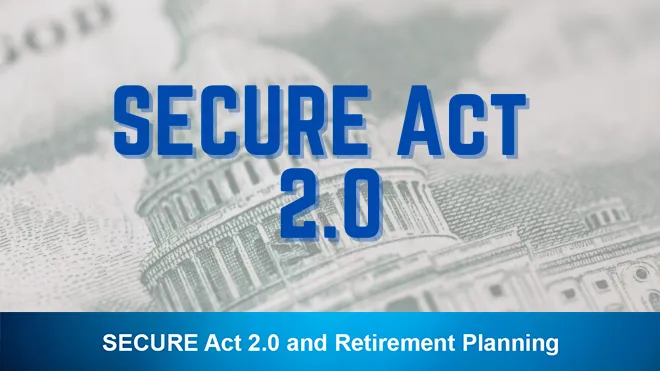SECURE ACT 2.0

In this holiday season, the government has given savers in retirement plans a gift in the form of enhancements to the SECURE ACT of 2019. The original SECURE ACT (Setting Every Community Up for Retirement Enhancement Act) increased the Required Minimum Distribution age to 72 among other changes for retirement savers. This time, they added the SECURE ACT 2.0 within the Appropriations Bill which will go into effect in 2023. Retirement savers will be happy to hear of the changes, of which are highlighted below.
The biggest change for retirement savers, which most people would applaud is the change to the Required Minimum Distribution age. Currently, the beginning age is 72. This is the age of forced distributions from qualified retirement accounts. Going into effect in 2023, the new Required Beginning Minimum Distribution age will now be 73. The rule states after December 31st, 2022, and before January 1st 2033, the applicable age is 73. If a person attains the age of 74 after December 31st, 2032, the applicable for Required Minimum Distributions is age 75. The effective date of this rule applies to RMD’s after December 31st, 2022.
Another big enhancement of the SECURE ACT 2.0 will help savers for retirement in qualified plans will allow for a higher catch up for savers age 60 to 63. If, by the end of the calendar year, a person is 60, 61, 62 or 63, then they are eligible for a catch up of up to $10,000. The amount is the greater of $10,000 or an amount equal to 150% of the dollar amount which would be in effect under such clause for 2024 for eligible participants. SIMPLE IRA’s will have a catch up of the greater of $5,000 or the amount equal to 150% of the dollar amount which would be in effect under such clause for 2025 for eligible participants.
Current catch-up contributions for age 50 or older will now be indexed for inflation whereas they were not previously indexed.
There are several other changes to the law that might not be as well published as the RMD age but not any less important. They include the treatment of student loan payments to be counted as elective deferrals for purposes of matching contributions. Employers will be able to match student loan payments.
It increases the credit for small employer pension plan startup costs. It is a 100% credit up to $1,000.
It allows for a Savers Match for any individual who makes a qualified retirement savings contribution for the taxable year. The match will be in the form of a tax credit. The contribution credit will be based upon a contribution up to $2,000.
Employer matching or non-elective contributions can now be designated as Roth contributions.
Military spouses will be eligible for a Retirement Plan credit for small employers of up to $200 or $300 over all employers’ plans.
It allows additional non-elective contributions to SIMPLE IRA’s. An employer is allowed to make non-elective contributions of a uniform percent up to 10% of compensation for each employee who is eligible. They must make at least $5,000 in compensation. The non-elective contribution maximum is $5,000.
The new law allows for Starter 401k plans for employers without a retirement plan. It provides for an automatic deferral for each eligible employee. Each employee is treated as having elected to have the employer make elective contributions in an amount equal to a qualified percentage of compensation.
The contribution is not to be less than 3% but no more than 15%. The maximum contribution is not to exceed $6,000. There is an allowable catch up after 50.
The new law allows for withdrawals for Certain Emergency Expenses from qualified retirement plans. A participant can withdraw up to $1,000 per calendar year. This amount may be repaid. There is a limit on subsequent distributions. If there was an amount treated as distribution in the previous three calendar years, then the distribution will not be deemed an emergency distribution unless the amount was fully repaid.
The Act allows for an Emergency Savings Account linked to individual account plans. It is a pension linked emergency savings account. It can be designated as a Roth for tax purposes. It will accept participant contributions. It cannot exceed the lesser of $2,500 or an amount determined by the plan sponsor of the pension linked emergency savings account.
The SECURE ACT 2.0 affects Qualified Longevity Annuity Contracts. It repeals the 25% limit of account balances. It also increases the base amount of $125,000 to $200,000.
It allows for the establishment of a searchable online database for participants to locate old retirement plan sponsors along with contact information. This will be known as the “Retirement Savings Lost and Found.” This will help savers locate money they may have left at old employers. The act will increase the minimum balance of cash out of inactive retirement plans from $5,000 to $7,000.
With regards to Qualified Charitable Distributions, it will allow for a distribution of up to $50,000 to go to a split interest entity such as a Charitable Remainder Trust.
It also allows for an eligible distribution for domestic abuse. The amount is the less of $10,000 of 50% of the balance in the plan.
One final note to be aware of is a special rule for certain distributions from a long-term qualified tuition programs to Roth’s. It allows for up to a lifetime maximum of $35,000 to be rolled over to a Roth IRA. The annual amount that can be rolled over is the annual contribution maximum. The distribution is allowed if the Qualified Tuition Plan is maintained for 15 years. The transfer must be a direct trustee to trustee transfer.
The SECURE Act 2.0 is designed to help Americans that are saving for retirement, and also allows for additional flexibility with regards to those using their plans. This will hopefully help Americans preparing for retirement, as many savers are significantly underfunded for a secure retirement.




